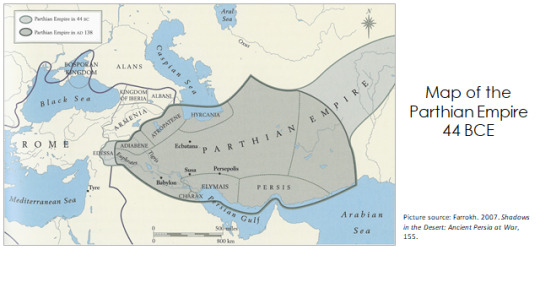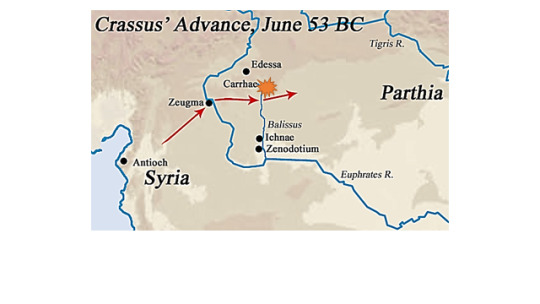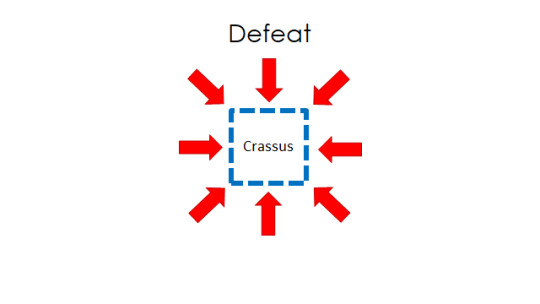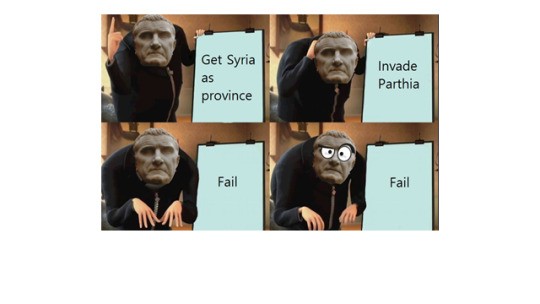#also. triumvirate: 'a group of three men holding power' (
Explore tagged Tumblr posts
Text

The triumvirate.
Also no, I don't think I can draw Bones looking normal. His eyes have to be that big sorry.
#I keep forgetting to color tge stripes on Spock's sleeves#also. triumvirate: 'a group of three men holding power' (#i googled it#trust me#star trek#star trek tos#star trek the original series#spock#s'chn t'gai spock#jim kirk#james t kirk#kirk#captain kirk#leonard mccoy#bones mccoy#doctor mccoy#spirk#mcspirk#whatever you want it to be I guess#mlp#my little pony#sponie#i love them#fanart#art#traditional art#mcpones#my new tag for pony Mccoy
121 notes
·
View notes
Text
Events 1.17
38 BC – Octavian divorces his wife Scribonia and marries Livia Drusilla, ending the fragile peace between the Second Triumvirate and Sextus Pompey. 1362 – Saint Marcellus' flood kills at least 25,000 people on the shores of the North Sea. 1377 – Pope Gregory XI reaches Rome, after deciding to move the Papacy back to Rome from Avignon. 1524 – Giovanni da Verrazzano sets sail westward from Madeira to find a sea route to the Pacific Ocean. 1562 – France grants religious toleration to the Huguenots in the Edict of Saint-Germain. 1595 – During the French Wars of Religion, Henry IV of France declares war on Spain. 1608 – Emperor Susenyos I of Ethiopia surprises an Oromo army at Ebenat; his army reportedly kills 12,000 Oromo at the cost of 400 of his men. 1648 – England's Long Parliament passes the "Vote of No Addresses", breaking off negotiations with King Charles I and thereby setting the scene for the second phase of the English Civil War. 1773 – Captain James Cook leads the first expedition to sail south of the Antarctic Circle. 1781 – American Revolutionary War: Battle of Cowpens: Continental troops under Brigadier General Daniel Morgan defeat British forces under Lieutenant Colonel Banastre Tarleton at the battle in South Carolina. 1799 – Maltese patriot Dun Mikiel Xerri, along with a number of other patriots, is executed. 1811 – Mexican War of Independence: In the Battle of Calderón Bridge, a heavily outnumbered Spanish force of 6,000 troops defeats nearly 100,000 Mexican revolutionaries. 1852 – The United Kingdom signs the Sand River Convention with the South African Republic. 1873 – A group of Modoc warriors defeats the United States Army in the First Battle of the Stronghold, part of the Modoc War. 1885 – A British force defeats a large Dervish army at the Battle of Abu Klea in the Sudan. 1893 – Lorrin A. Thurston, along with the Citizens' Committee of Public Safety, led the Overthrow of the Kingdom of Hawaii and the government of Queen Liliʻuokalani. 1899 – The United States takes possession of Wake Island in the Pacific Ocean. 1903 – El Yunque National Forest in Puerto Rico becomes part of the United States National Forest System as the Luquillo Forest Reserve. 1904 – Anton Chekhov's The Cherry Orchard receives its premiere performance at the Moscow Art Theatre. 1912 – British polar explorer Captain Robert Falcon Scott reaches the South Pole, one month after Roald Amundsen. 1915 – Russia defeats Ottoman Turkey in the Battle of Sarikamish during the Caucasus Campaign of World War I. 1917 – The United States pays Denmark $25 million for the Virgin Islands. 1918 – Finnish Civil War: The first serious battles take place between the Red Guards and the White Guard. 1920 – Alcohol Prohibition begins in the United States as the Volstead Act goes into effect. 1941 – Franco-Thai War: Vichy French forces inflict a decisive defeat over the Royal Thai Navy. 1943 – World War II: Greek submarine Papanikolis captures the 200-ton sailing vessel Agios Stefanos and mans her with part of her crew. 1944 – World War II: Allied forces launch the first of four assaults on Monte Cassino with the intention of breaking through the Winter Line and seizing Rome, an effort that would ultimately take four months and cost 105,000 Allied casualties. 1945 – World War II: The Vistula–Oder Offensive forces German troops out of Warsaw. 1945 – The SS-Totenkopfverbände begin the evacuation of the Auschwitz concentration camp as Soviet forces close in. 1945 – Swedish diplomat Raoul Wallenberg is taken into Soviet custody while in Hungary; he is never publicly seen again. 1946 – The UN Security Council holds its first session. 1948 – The Renville Agreement between the Netherlands and Indonesia is ratified. 1950 – The Great Brink's Robbery: Eleven thieves steal more than $2 million from an armored car company's offices in Boston. 1950 – United Nations Security Council Resolution 79 relating to arms control is adopted. 1961 – U.S. President Dwight D. Eisenhower delivers a televised farewell address to the nation three days before leaving office, in which he warns against the accumulation of power by the "military–industrial complex" as well as the dangers of massive spending, especially deficit spending. 1961 – Former Congolese Prime Minister Patrice Lumumba is murdered in circumstances suggesting the support and complicity of the governments of Belgium and the United States. 1966 – Palomares incident: A B-52 bomber collides with a KC-135 Stratotanker over Spain, killing seven airmen, and dropping three 70-kiloton nuclear bombs near the town of Palomares and another one into the sea. 1969 – Black Panther Party members Bunchy Carter and John Huggins are killed during a meeting in Campbell Hall on the campus of UCLA. 1977 – Capital punishment in the United States resumes after a ten-year hiatus, as convicted murderer Gary Gilmore is executed by firing squad in Utah. 1981 – President of the Philippines Ferdinand Marcos lifts martial law eight years and five months after declaring it. 1991 – Gulf War: Operation Desert Storm begins early in the morning as aircraft strike positions across Iraq, it is also the first major combat sortie for the F-117. LCDR Scott Speicher's F/A-18C Hornet from VFA-81 is shot down by a Mig-25 and is the first American casualty of the War. Iraq fires eight Scud missiles into Israel in an unsuccessful bid to provoke Israeli retaliation. 1991 – Crown prince Harald V of Norway becomes King Harald V, following the death of his father, King Olav V. 1992 – During a visit to South Korea, Japanese Prime Minister Kiichi Miyazawa apologizes for forcing Korean women into sexual slavery during World War II. 1994 – The 6.7 Mw Northridge earthquake shakes the Greater Los Angeles Area with a maximum Mercalli intensity of IX (Violent), leaving 57 people dead and more than 8,700 injured. 1995 – The 6.9 Mw Great Hanshin earthquake shakes the southern Hyōgo Prefecture with a maximum Shindo of VII, leaving 5,502–6,434 people dead, and 251,301–310,000 displaced. 1996 – The Czech Republic applies for membership of the European Union. 1997 – Cape Canaveral Air Force Station: A Delta II carrying the GPS IIR-1 satellite explodes 13 seconds after launch, dropping 250 tons of burning rocket remains around the launch pad. 1998 – Lewinsky scandal: Matt Drudge breaks the story of the Bill Clinton–Monica Lewinsky affair on his Drudge Report website. 2002 – Mount Nyiragongo erupts in the Democratic Republic of the Congo, displacing an estimated 400,000 people. 2007 – The Doomsday Clock is set to five minutes to midnight in response to North Korea's nuclear testing. 2010 – Rioting begins between Muslim and Christian groups in Jos, Nigeria, results in at least 200 deaths.
1 note
·
View note
Text
• Blades of the Phoenix •


Members of the Blood Knights, the Farstriders, and the Magisters have all come together under one banner. Together, they have signed what is known to their order as ‘The Phoenix Accord’; An agreement to treat one and other equally as one force. The protection of Quel’thalas and her people are the main goal.
A fresh, new heavy roleplay guild formed between a merge of <The Blood Offensive> and <The Sunblood Bulwark>! Our premise is a cooperative effort between the Magisterium, the Farstriders, and the Blood Knights with the idea to better defend Quel'thalas and advance the interest of the Sin'dorei at large.
Blades of the Phoenix operates as three separate groups under one banner, maintaining the individuality of each even when they come together, fighting side by side in defense of their homeland. We allow more than just the three to join, however, and can advance in rank with the blessing and servitude with either of the three. If enough of the same life path were to be in force, adjustments can be made to accommodate.

The Triumvirate
Each section, while being apart of the guild, is separate and will have events that are themed after their respective roles. You can expect political/magical roleplay with the Magisters, outdoorsy scouting, and infiltration with the Farstriders, and Light/Knightly roleplay with the Blood Knights. There will also be a significant overlap between all three at times!
The Blood Knights.
Rising from their unproven and scorned beginnings, the Blood Knights have become one of the most popular groups in Sin’dorei society. With Lady Liadrin at their helm, though often away on business, it is up to those that work beneath her to ensure the men and women of the Blood Knight order carry out their duties.
Division Leader: Sarthyr Alya’endil Archon: Enthiel Al’alora

The Farstriders.
An elite group of Sin’dorei Rangers, the Farstriders are led by none other than the esteemed Halduron Brightwing. Intimately bound to the wildlands, and with a deep respect for the law, the rangers that compose the Farstriders' ranks remain noble, traditional, and valiant protectors of blood elf society.
Division Leader: Vylara Dal’danil Archon: Slade Ar’nareth

The Magisters.
A prominent group of Sin’dorei mages and one of the three major factions of the Silvermoon City governing body, the Magisters are arguably the most powerful political group in Silvermoon, with its leaders having strong historic ties to the upper echelons of the city.
Division Leader: Open Archon: Open

• What You Can Expect •
Immersive, story-driven roleplay!
One of the main goals of the Blades of the Phoenix is to promote & provide an immersive and story-driven roleplay environment for all of its members. Together, it is our plan to create long term story arches that revolve around training, combat, diplomacy, social events, and so much more!
Character Development!
Nothing is more satisfying than progressing a character through active and meaningful roleplay. It is one of the goals of our team to assist in providing all of our members with roleplay that will both challenge and entertain you the player. Through this, we hope, it will be possible to truly develop your characters in meaningful ways.
A True Focus on Sin’dorei Culture!
With so many guilds leaning into the ‘For the Horde’ category, we at Blades of the Phoenix wanted to get back to the heart of Sin’dorei roleplay. Our guild will be based out of Quel’thalas and will focus on the needs and culture of the Sin’dorei people first and foremost. Because of these values, we will be mainly focused on accepting Sin’dorei roleplayers. Though the occasional Shal’dorei may be accepted, this is not to be considered the norm and will be very heavily considered on a case by case situation.
Friendly and Easy Going Leaders!
We know how hard it can be to join a guild with people you may not know. Our Co-Leaders and Officer Core are made up friendly, long time roleplayers who are willing to assist in anything you made need. We are LGBTQ friendly and open and accepting to all!

• Phoenix Ranking Structure •

The ranking structure of Blades of the Phoenix will vary from division to division. What this means is, each individual group will have ranks for your character to ICly move through, adding to character development as they are promoted. Because of limited space, the actual number of ranks is limited.

The available ranks within the physical guild structure are as follows:
Knight-Lord • Ranger-Lord • Lord-Magister
“The Leaders”
These three ranks hold the same level of responsibility. They are saved for the three Co-Gleads and will not be offered to the player base at large. These are the main division leaders and the men and women whom all members answer to.
Archon
“The Most Trusted”
Archons are those who have not only excelled within the Blades and shown themselves capable, loyal and true but they have captured the trust of their respective Lords. These members are those who help put the ideas and tasks of their order into motion and council their Lords on what they may also think of the progress of their people.
Phoenix Captain
“The Elite”
Those who have gone above and beyond the call of duty. Those who have shown not only pride for their people but for the Blades of the Phoenix. The leaders, the loyal, and the true. These brave men and women have been commended for their contributions to their respective orders and are elevated above the rest as the elite force of the Blades of the Phoenix.
Phoenix Guard
“The Body of the Phoenix”
Those who achieve the rank of Phoenix Guard make up the majority of the Blades. Not only have they gone through their trials as a recruit, but they have also proven their worth and prowess to their order enough that they are deemed worthy to become a brother or sister in arms.
Phoenix Blade
“The Trialed”
The Blades are those who are fresh from their recruitment phase and have been given the opportunity to join the order properly. It is during each members time in the Phoenix Blade that they might focus on training, apprenticing or simply proving to their colleagues that they are worthy for the title of Guard and be given the equal footing to their orders that those before them have attained and continue to uphold.
Recruit
“The Unknown”
A recruit is new to the order in its entirety and these first weeks of their time under the banner determine whether or not they are determined worthy of the honor of becoming a Blade and potentially achieving the position of Phoenix Guard. It is this time that they are expected to get to know their prospective colleagues, make themselves and their intentions known to their desired orders Lords and prepare for the difficult but fulfilling journey ahead.
Auxiliary
“Allies in Arms”
Not everyone wants to dedicate themselves entirely to one cause, but their Blade and support are openly given to others. This rank is for those who do not wish to lose their currently established title or to climb the ranks of the Blades of the Phoenix but also wish to work closely with the order in a supplementary role. They will still be treated with the utmost respect, as any enlisted member would, and they will also be allowed to attend any event that fits their character.

We are looking forward to kicking this guild project into overdrive with open recruitment starting now! Feel free to reach out to any of our members as they can get you into contact with someone who can answer any and all of your questions!
Glory to the Sin’dorei!

#wra#wra rp#sin'dorei#Blades of the Phoenix#Farstriders#Blood Knights#Magisters#Silvermoon City#roleplay
29 notes
·
View notes
Text
Military Monday | Crassus’ Parthian Campaign
A Pint of History is a local history seminar series based in Hobart, which is run every third Thursday of the month. History is full of drinking. Be it alcoholic or non-, made from fruit, grain, spuds or sugar. In sorrow or celebration, glasses have been raised, from battlefields to children's parties. We continue the tradition, bringing tales of old to the pub – Shambles Brewery. Each month we set a different topic and some of Hobart's (and Tasmania’s) leading historians get ten minutes each to guide a group of amateur historians and history enthusiasts through the quirky, entertaining, and downright confusing people and events of the past.
Last week, after being part of the team for a year, I finally presented at A Pint of History. The topic: #EpicFail. I told the tale of Marcus Licinius Crassus’ woeful journey into Parthia and, with it being Military Monday, I thought I would post my presentation. Unfortunately, I don’t have a recording of it but I hope it will be an interesting read!
~ admin @sassy-cicero-says


Although remembered for being Rome’s richest man, Marcus Licinius Crassus was also a successful politician who made his way up through the ranks to hold his first consulship in 70 BCE. He was considered by his contemporaries to be a quiet, straight-forward speaker in the law courts of the time, and as a general, he was known for his zeal and courage in the civil war of 83 and 82 BCE, and a decade later he was instrumental in suppressing the servile revolt led by Spartacus where others had failed. He was an ambitious man – he sought power, as did all leading men in Rome. It led him to form a partnership in 59 BCE, known as the first triumvirate

The triumvirate was an amicitia, an unofficial coalition between two leading politicians – Crassus and Pompeius – and a then junior politician, Caesar, whose death you may be more familiar with than his life.

Essentially, the triumvirate was a personal agreement formed so they could work towards their own political ends. Who was responsible for forming the coalition? Well, that depends on who you ask, and I’m not going to add to the debate today. The important thing is to understand what motivated Crassus to take part in this alliance.

Power in Rome was influenced by auctoritas gained in political and military pursuits, of which glōria was also an important influencing factor. Politically, Crassus’ career was typical for a man from a prominent family; there was little to distinguish him from his peers. Militarily, while he’d been instrumental in repressing the servile revolt, Pompeius stole some of his thunder by arriving at the last minute and slaughtering thousands of the adversary as they fled. And, because the victory was over slaves, it wasn’t deemed as worthy as an international conquest. Crassus saw Parthia as an opportunity, a challenge. Success would mean a triumph and recognition of his prowess as a general. It would also add to his personal prestige and wealth.
The Expedition
So, with the help of his fellow triumvirs, Crassus received Syria as his province in 55 BCE. provincia was not a geographical descriptor as we understand it today. Instead, it was a responsibility assigned to Roman officials that could be militaristic or administrative in nature. In the case of Syria, Crassus recognised the potential to open opportunities as far as Bactria, India, and the Outer Ocean but there was no mention of war with Parthia in the law which gave Crassus his command. His intent was still evident, as Plutarch tells us: “there was a considerable part who objected strongly to the idea of a man going out to make war on people who, so far from having done any harm to the Romans, were bound to them by treaties of friendship.” (Plutarch, Crassus 16)

But Parthia was in a state of civil war, making conditions ideal for intervention. Orodes, the ruler at the time of Crassus’ arrival in the east, stood undisputed, but his throne was insecure. The unrest, it was argued, represented a threat to Roman interests in the area, although analysis of the sources suggests this argument was weak at best: Parthia’s preoccupation with internal disturbances effectively prevented indulgence in international adventures. But, like Gabinius before him, Crassus used a perverted interpretation of his provincial command to attack Parthia who Cicero, our only contemporary source, numbered among the most peaceful of nations.
Indeed our sources, most of which have the advantage of hindsight, believe that Crassus’ expedition was doomed from the start. Crassus supposedly ignored every bad omen, from a violent lightning storm, to the eagle on the first standard raised facing about on its own accord. Ateius, one of the tribunes of the time, even cursed Crassus’ expedition – an event Cicero confirms in his writings.

Yet Crassus pressed on, and Parthia, despite the threat of invasion, wanted to maintain the friendly terms they’d enjoyed with Rome for some thirty years. As Plutarch tells us, ambassadors came to Crassus from Arsaces [Parthia] with a short message: “If, they said, this army had been sent out by the Roman people, then it meant war to the bitter end with no question of negotiations. But if, as they had been informed, the fact was that Crassus, for his own private profit and against the wishes of his countrymen, had invaded Parthia and occupied Parthian territory, then Arsaces was prepared to adopt a reasonable attitude: he [Orodes] would take pity on Crassus as an old man, and as for his soldiers, who were rather in the position of Crassus’ prisoners than his protectors, he would allow them to go back to Rome.” (Plutarch, Crassus 18)
Defeat
As you probably guessed by the title, Crassus’ expedition did not fare well. According to tradition, he made three major mistakes which contributed to his downfall. First, after crossing into Mesopotamia in 54 BCE:

He failed to follow through with an assault on Seleucia and Ctesiphon, despite successfully capturing one city and receiving the surrender of several others.

He instead chose to withdraw to Syria for the winter:

This gave the Parthians time to prepare for his impending attack. Crassus also ignored the King of Armenia’s advice to march through Armenia where he would be well supplied and could march in safety, protected by the mountains and country generally unsuited to cavalry operations:

Instead, Crassus listened to the advice of a treacherous pretend ally and abandoned the Euphrates river – his supply line. He then marched across the arid plains of central Mesopotamia to meet the Surena, the Parthian General, and his army:

Although Crassus’ army boasted seven infantry legions plus four thousand auxiliary cavalry and light-armed troops (outnumbering Parthia’s army) they were ill-prepared to face the all-cavalry force of the Parthians. The combination of cataphracts – heavy-armed cavalry – and mounted archers proved unstoppable. When the two forces met at a location near Carrhae, the Parthian cataphracts and mounted archers overpowered Crassus’ mainly infantry force.


Crassus, fearing he would be entirely surrounded, sent a message to his son asking him to join the battle. Publius, with 1,300 cavalry, 500 archers, and 8 cohorts from the infantry led them forward. Upon seeing the advance, the Parthians who were trying to encircle Crassus turned back, drawing Publius away from his father.

Crassus received news of his son’s dire situation, but before he and his remaining forces could reach Publius, Parthian men came carrying the head of Publius fixed on a spear – it was this sight, Plutarch tells us, that “broke the spirit and paralysed the energies of the Romans.” (Plutarch, Crassus 26)

At nightfall, they withdrew to bury their dead and tend to the wounded and dying.

Following the battle, the Surena approached Crassus, who had taken refuge on a hill. He came in person to offer a truce. He said, Plutarch tells us, “that from now on a state of peace existed between King Hyrodes and the Romans; it was necessary, however, to go forward as far as the river [Euphrates] and have the terms of agreement put into writing. ‘We find,’ he added, ‘that you Romans have not got very good memories about the terms of treaties.’” (Plutarch, Crassus 31). Once Crassus came down from his position, however, a brawl broke out between the groups, and a Parthian killed Crassus. The Surena then took his head and hand as he lay on the ground, sending it to Hyrodes.
So, to put it shortly. Ouch.

Crassus’ defeat remained a great source of shame and humiliation for the Romans centuries later, and Romans agreed that the great blow to their prestige and power could only be avenged by a successful war, an attitude which influenced Roman policy towards Parthia for decades. Crassus’ loss was truly a Roman #EpicFail.
To finish off, and perhaps lighten the mood, here’s a quick summary of Crassus’ misadventure:

Select Bibliography:
Cassius Dio, Roman History. Translated by Earnest Cary. 1914. London: William Heinemann.
Cicero, De Divinatione. Translated by William Armistead Falconer. 1932. Cambridge MA: Harvard UP.
Plutarch, Life of Crassus. Translated by Rex Warner. 2005. London: Penguin Books Ltd.
Keaveney, A. 1982. “The King and the War-Lords: Romano-Parthian Relations Circa 64-53 B.C.” The American Journal of Philology 103.4: 412-428.
Mattern-Parkes, S. P. 2003. “The Defeat of Crassus and the Just War.” The Classical World 96.4: 387-396.
Simpson, A. D. 1938. “The Departure of Crassus for Parthia.” Transactions and Proceedings of the American Philological Association 69: 532-541.
Further reading:
Marshall, B. A. 1976. Crassus: A Political Biography. Amsterdam: Adolf M. Hakkert.
Ward, A. M. 1977. Marcus Crassus and the Late Roman Republic. Columbia: University of Missouri Press.
#classics#tagamemnon#tagitus#military monday#militarymonday#theme#daily theme#crassus#marcus licinius crassus#rome#ancient rome#roman republic#republic#late republic#roman history#history#ancient history#ancient roman history#a pint of history#presentation#my presentation#my work#sassy's scholarship#meme#classics meme#powerpoint#slides#images#parthia#crassus' parthian campaign
48 notes
·
View notes
Text
Review: Sebastien de Castell, “Traitor’s Blade” & “Knight’s Shadow”

My name is Falcio val Mond, one of the last of the King's Greatcoats, and if you listen very carefully you might still be able to hear me screaming.
- Knight’s Shadow
I’ve always had a soft spot for reluctant heroes. Their hesitance often speaks to a kind of endearing humility that you don’t find in either the earnest Chosen Ones of high fantasy or the slippery antiheroes of grimdark. It can also be an “emperor’s new clothes” situation, where they initially refuse the call to adventure on the grounds that they have too much to lose – what sane person with people to protect, after all, would agree to subject themselves and their loved ones to anything like the hero’s journey?

[Right you are, Rocket.]
Falcio val Mond, protagonist of Sebastien de Castell’s Greatcoat series, is the epitome of the reluctant hero. Falcio has no reason to be humble, though he often is – he’s perhaps the best fencer in the world, the handpicked right-hand man of a once-powerful king, and the leader of a far-flung group of warrior-magistrates who categorically bow to no one and whose meager goal is to restore peace and justice to the land. He also has little to lose – by the time the first book picks up, both his saintly wife and his beloved king are long dead, killed horribly in ways Falcio was powerless to avert. Instead, from the very first of over two thousand pages, Falcio wants nothing more than to die, and the events of the series – plucky rescues, daring escapes, and hair-raising duels choreographed as tightly as neurosurgical procedures – are minor speedbumps on his path to rejoin those he loves in the afterlife. To Falcio, death is the carrot on a stick that he chases unwillingly through the hoops of herohood, and against all odds, it’s an absolute joy to watch.
For a man more or less constantly on the lookout for ways to die – especially, in Falcio’s case, for ways to nobly sacrifice himself for king and country – the world of the Greatcoats series offers opportunities around every corner. The kingdom of Tristia, an Alexandre Dumas-esque land which it seems almost compulsory to call “swashbuckling,” was once steered towards socialistic utopia by the benevolent machinations of the idealistic young King Paelis. Five years ago, the local Dukes, from whom Paelis was trying to wrest power, banded together to have him killed. All that remains of Paelis’ legacy are the Greatcoats – musketeer-like magistrates and masters of fencing, singing, and law who roam the land settling disputes between the common folk and their cruel overlords. Their secret weapon? The “greatcoats” from which they draw their name – uniforms, Bags of Holding, and bulletproof vests all in one thanks to hidden pockets and bone plates sewn into the leather – which along with their skills make them nigh-unkillable. In the years since the king’s death, however, Greatcoats – or “Tattercloaks,” as they are derogatorily called – have become the political scapegoats (or “scapecoats,” if you will) du jour, blamed for everything from the current plight of the poor to the suspicious deaths of powerful Dukes.

[Some people even respect the Greatcoats as opponents, but that doesn’t stop them from wanting or trying to kill them at every opportunity.]
Hunted and/or hated by everyone from the Dukes and their retained knights to a mysterious order of world-class assassins to the average guy on the street, for Falcio, the so-called “First Cantor of the Greatcoats,” life is an endless procession of narrow brushes with death, usually the result of some barely-eked-out victory in the face of impossible odds. It’s a good day for the First Cantor if he doesn’t end it by passing out from blood loss for the next week (the punchline of more than a few chapters in first book Traitor’s Blade) after a fierce fight or a bout of torture. In sequel Knight’s Shadow/Greatcoat’s Lament, Falcio spends most of the novel slipping irreversibly into death as a slow-acting poison gradually paralyzes him. By Saint’s Blood, the third in the series, Falcio’s tendency towards being very nearly killed – and his equal propensity for jumping back into the fray only half-healed because the world is on line and there just isn’t time – is a running joke that almost everyone in Tristia is in on. What impresses me most about the series is that, despite Falcio’s tendency to fail or nearly fail at almost everything he does, he never feels underpowered as a character – instead, the compelling antagonists against whom he faces off are developed in such a way as to create the sense that Falcio is an extraordinary protagonist whose bare and often pyrrhic victories are nonetheless admirable in the face of very capable villains and almost certain disaster.

[Just another day at the office for Falcio val Mond.]
If Falcio sounds a bit unbalanced as a character, he is, but purposefully so; as with the Greatcoats’ musketeer models, he constitutes just one third of a triumvirate of lead characters who together make up a single semi-functional human. Serving as counterpoints to Falcio’s passionate idealism and suicidal spontaneity are the stoic, logical, and fiercely loyal Kest, whose mastery of the sword rivals Falcio’s; and Brasti, who eschews the seriousness of the other two for persistent sarcasm and practical joking and trades the typical fencing foil for a trio of imposingly-named greatbows that, in his capable hands, may as well be sniper rifles. The friendship between the three is one of the series’ greatest strengths, and plot points which occasionally separate them left me counting down the pages until their reunion.
Seeing as the series’ main trio of men are characterized as the embodiment of certain traits, it’s perhaps unsurprising that their female counterparts start out equally archetypical. Unfortunately, however, without the additive and complimentary relationship shared by Falcio, Kest, and Brasti, the series’ scattered archetypical females tend to come across (at least at first) less as timelessly heroic and more as two-dimensional. Falcio’s wife, whose honor was besmirched in a Braveheart-esque turn before her untimely death, initially codes as an impossibly good “angel of the house” and little more than a motivator for Falcio, fueling his homicidal anger at ne’er-do-wells and his underlying desire to die. His new love interest begins life as a pretty stereotypical female healer support character to the mostly male movers and shakers. Several teenage damsels cycle in and out of the plot of Traitor’s Blade at regular intervals as big strong Falcio selflessly rescues them from certain death again and again. Most egregiously of all, the female villains who (spoilers) eventually emerge as the puppeteers of each book’s grand conspiracies are primarily characterized as evil through their sexual aggression and kinkiness – a particularly ironic case of the pot calling the kettle black considering the novels’ seeming obsession with keeping Falcio bloodied and half-dead at every turn.

[At one point, Falcio is literally crucified and tortured for over a week, during which the novel toes the line between whump and something more… vindictive.]
Luckily, however, many of these characters make great strides over the course of the first two books. Healer Ethalia shucks the angel’s endless patience, holding Falcio accountable for his choices and actions and refusing to support him unconditionally. Falcio’s female wards become deadly warriors and serious political players in their own right, similarly stepping out of Falcio’s shadow and finding their own priorities. The series also introduces memorable female characters who work against other stereotypes – the supernatural sage who guides the heroes on their quest, for example, is a morally dubious, scheming old woman who spends more time scolding the Three Greatcoateers for running afoul of her plans than she does actually helping them, undercutting both the classic male sage and the mother-figureness of female spirit guides. Marking this great progress over the course of a couple books, I’m crossing my fingers the rest of the series will undergo a similar evolution with regards to sexuality. The way the novels develop the trio’s bromance and import a lot of seventeenth-century social norms has kept the world pretty firmly heteronormative thus far, though a few hints here and there have opened a fissure in this facade that I’m holding out hope is expanded in installments to come.

[Because we all know manly devotion doesn’t always have to be totally definitely 100% straight.]
Perhaps my greatest initial reservation about the Greatcoats series was its meticulous focus on fencing in its many, many fight scenes. I had read in a blurb that the author was a professional fight choreographer and feared that, just as the linguistics-obsessed among us have a tendency to undertake pages-long fights of fancy about the etymologies of invented words, the fight scenes would devolve into extended chunks of jargon that the average layman wouldn’t be able to make heads or tails of, let alone enjoy. Imagine my surprise, then, when I found the deft and precise explanations of combat maneuvers to be some of my absolute favorite parts. Narrator Falcio balances the clear and evocative explanations of a patient and experienced teacher with snappy humor and rapid-fire pacing to create not just the image of a fencing match, but the emotional rollercoaster and the rhythm of one on the sentence level. As such, these sequences move the plot forward thrillingly rather than forcing it into an eddy (a.k.a. Naruto syndrome) and further characterize Falcio and his friends as knowledgeable masters of their respective martial crafts. It almost makes me miss my high school fencing lessons… almost.
For anyone already eager to jump into Falcio’s tempestuous adventures – or even those on the fence – I can’t recommend strongly enough that you check out the audiobook versions of the series. As an auditory learner, a compulsive multitasker, and a grad student with waning eyesight, I seek out audiobooks at almost any cost, up to and including suffering through stilted narration and dubious character voices if it means not having to subject my eyes to 500 plus pages of tiny paperback print. Greatcoats narrator Joe Jameson is not only perfectly cast as Falcio, but a joy to listen to. At 1.75x speed (a leisurely pace compared to the 2.5x or 3x I usually aim for when reading for work), his cadence and inflection are engaging and lifelike, capturing especially well the main trio’s personalities and mannerisms, and even his soprano-pitched female voices hold up to the chipmunk test. Armed with the audiobooks and a lot of menial labor I needed distracting from, I tore through the first and second volumes of the series in just a few days and have happily started the third. Falcio may be itching for the Great Beyond, but here’s me hoping he, his companions, and their collective hijinks stick around for many, many books to come.
#reviews#sebastien de castell#greatcoats#falcio val mond#kest#brasti goodbow#traitor's blade#knight's shadow#fantasy
6 notes
·
View notes
Text
Events 1.17
38 BC – Octavian divorces his wife Scribonia and marries Livia Drusilla, ending the fragile peace between the Second Triumvirate and Sextus Pompey. 1287 – The Treaty of San Agayz is signed. King Alfonso III of Aragon conquers the island of Menorca from the Moors. 1362 – Saint Marcellus' flood kills at least 25,000 people on the shores of the North Sea. 1377 – Pope Gregory XI reaches Rome, after deciding to move the Papacy back to Rome from Avignon. 1524 – Giovanni da Verrazzano sets sail westward from Madeira to find a sea route to the Pacific Ocean. 1562 – France recognizes the Huguenots by the Edict of Saint-Germain. 1595 – During the French Wars of Religion, Henry IV of France declares war on Spain. 1608 – Emperor Susenyos I of Ethiopia surprises an Oromo army at Ebenat; his army reportedly kills 12,000 Oromo at the cost of 400 of his men. 1648 – England's Long Parliament passes the "Vote of No Addresses", breaking off negotiations with King Charles I and thereby setting the scene for the second phase of the English Civil War. 1773 – Captain James Cook commands the first expedition to sail south of the Antarctic Circle. 1781 – American Revolutionary War: Battle of Cowpens: Continental troops under Brigadier General Daniel Morgan defeat British forces under Lieutenant Colonel Banastre Tarleton at the battle in South Carolina. 1799 – Maltese patriot Dun Mikiel Xerri, along with a number of other patriots, is executed. 1811 – Mexican War of Independence: In the Battle of Calderón Bridge, a heavily outnumbered Spanish force of 6,000 troops defeats nearly 100,000 Mexican revolutionaries. 1852 – The United Kingdom signs the Sand River Convention with the South African Republic. 1873 – A group of Modoc warriors defeats the United States Army in the First Battle of the Stronghold, part of the Modoc War. 1885 – A British force defeats a large Dervish army at the Battle of Abu Klea in the Sudan. 1893 – Lorrin A. Thurston, along with the Citizens' Committee of Public Safety, led the Overthrow of the Kingdom of Hawaii and the government of Queen Liliʻuokalani. 1899 – The United States takes possession of Wake Island in the Pacific Ocean. 1903 – El Yunque National Forest in Puerto Rico becomes part of the United States National Forest System as the Luquillo Forest Reserve. 1904 – Anton Chekhov's The Cherry Orchard receives its premiere performance at the Moscow Art Theatre. 1912 – British polar explorer Captain Robert Falcon Scott reaches the South Pole, one month after Roald Amundsen. 1915 – Russia defeats Ottoman Turkey in the Battle of Sarikamish during the Caucasus Campaign of World War I. 1917 – The United States pays Denmark $25 million for the Virgin Islands. 1918 – Finnish Civil War: The first serious battles take place between the Red Guards and the White Guard. 1920 – Alcohol Prohibition begins in the United States as the Volstead Act goes into effect. 1929 – Popeye the Sailor Man, a cartoon character created by E. C. Segar, first appears in the Thimble Theatre comic strip. 1941 – Franco-Thai War: Vichy French forces inflict a decisive defeat over the Royal Thai Navy. 1943 – World War II: Greek submarine Papanikolis captures the 200-ton sailing vessel Agios Stefanos and mans her with part of her crew. 1944 – World War II: Allied forces launch the first of four assaults on Monte Cassino with the intention of breaking through the Winter Line and seizing Rome, an effort that would ultimately take four months and cost 105,000 Allied casualties. 1945 – World War II: The Vistula–Oder Offensive forces German troops out of Warsaw. 1945 – The SS-Totenkopfverbände begin the evacuation of the Auschwitz concentration camp as Soviet forces close in. 1945 – Swedish diplomat Raoul Wallenberg is taken into Soviet custody while in Hungary; he is never publicly seen again. 1946 – The UN Security Council holds its first session. 1948 – The Renville Agreement between the Netherlands and Indonesia is ratified. 1950 – The Great Brink's Robbery: Eleven thieves steal more than $2 million from an armored car company's offices in Boston. 1950 – United Nations Security Council Resolution 79 relating to arms control is adopted. 1961 – U.S. President Dwight D. Eisenhower delivers a televised farewell address to the nation three days before leaving office, in which he warns against the accumulation of power by the "military–industrial complex" as well as the dangers of massive spending, especially deficit spending. 1961 – Former Congolese Prime Minister Patrice Lumumba is murdered in circumstances suggesting the support and complicity of the governments of Belgium and the United States. 1966 – Palomares incident: A B-52 bomber collides with a KC-135 Stratotanker over Spain, killing seven airmen, and dropping three 70-kiloton nuclear bombs near the town of Palomares and another one into the sea. 1969 – Black Panther Party members Bunchy Carter and John Huggins are killed during a meeting in Campbell Hall on the campus of UCLA. 1977 – Capital punishment in the United States resumes after a ten-year hiatus, as convicted murderer Gary Gilmore is executed by firing squad in Utah. 1981 – President of the Philippines Ferdinand Marcos lifts martial law eight years and five months after declaring it. 1991 – Gulf War: Operation Desert Storm begins early in the morning as aircraft strike positions across Iraq, it is also the first major combat sortie for the F-117. LCDR Scott Speicher's F/A-18C Hornet from VFA-81 is shot down by a Mig-25 and is the first American casualty of the War. Iraq fires eight Scud missiles into Israel in an unsuccessful bid to provoke Israeli retaliation. 1991 – Crown prince Harald V of Norway becomes King Harald V, following the death of his father, King Olav V. 1992 – During a visit to South Korea, Japanese Prime Minister Kiichi Miyazawa apologizes for forcing Korean women into sexual slavery during World War II. 1994 – The 6.7 Mw Northridge earthquake shakes the Greater Los Angeles Area with a maximum Mercalli intensity of IX (Violent), leaving 57 people dead and more than 8,700 injured. 1995 – The 6.9 Mw Great Hanshin earthquake shakes the southern Hyōgo Prefecture with a maximum Shindo of VII, leaving 5,502–6,434 people dead, and 251,301–310,000 displaced. 1996 – The Czech Republic applies for membership of the European Union. 1997 – Cape Canaveral Air Force Station: A Delta II carrying the GPS IIR-1 satellite explodes 13 seconds after launch, dropping 250 tons of burning rocket remains around the launch pad. 1998 – Lewinsky scandal: Matt Drudge breaks the story of the Bill Clinton–Monica Lewinsky affair on his Drudge Report website. 2002 – Mount Nyiragongo erupts in the Democratic Republic of the Congo, displacing an estimated 400,000 people. 2007 – The Doomsday Clock is set to five minutes to midnight in response to North Korea's nuclear testing. 2010 – Rioting begins between Muslim and Christian groups in Jos, Nigeria, results in at least 200 deaths.
1 note
·
View note
Text
Events 1.17
38 BC – Octavian divorces his wife Scribonia and marries Livia Drusilla, ending the fragile peace between the Second Triumvirate and Sextus Pompey. 395 – Upon the death of Emperor Theodosius I, the Roman Empire is permanently divided into the Eastern Roman Empire under Arcadius, and the Western Roman Empire under Honorius. 1287 – The Treaty of San Agayz is signed. King Alfonso III of Aragon conquers the island of Menorca from the Moors. 1377 – Pope Gregory XI moves the Papacy back to Rome from Avignon. 1524 – Giovanni da Verrazzano sets sail westward from Madeira to find a sea route to the Pacific Ocean. 1562 – France recognizes the Huguenots by the Edict of Saint-Germain. 1595 – During the French Wars of Religion, Henry IV of France declares war on Spain. 1608 – Emperor Susenyos I of Ethiopia surprises an Oromo army at Ebenat; his army reportedly kills 12,000 Oromo at the cost of 400 of his men. 1648 – England's Long Parliament passes the "Vote of No Addresses", breaking off negotiations with King Charles I and thereby setting the scene for the second phase of the English Civil War. 1773 – Captain James Cook commands the first expedition to sail south of the Antarctic Circle. 1781 – American Revolutionary War: Battle of Cowpens: Continental troops under Brigadier General Daniel Morgan defeat British forces under Lieutenant Colonel Banastre Tarleton at the battle in South Carolina. 1799 – Maltese patriot Dun Mikiel Xerri, along with a number of other patriots, is executed. 1811 – Mexican War of Independence: In the Battle of Calderón Bridge, a heavily outnumbered Spanish force of 6,000 troops defeats nearly 100,000 Mexican revolutionaries. 1852 – The United Kingdom signs the Sand River Convention with the South African Republic. 1873 – A group of Modoc warriors defeats the United States Army in the First Battle of the Stronghold, part of the Modoc War. 1885 – A British force defeats a large Dervish army at the Battle of Abu Klea in the Sudan. 1893 – Lorrin A. Thurston, along with the Citizens' Committee of Public Safety, led the Overthrow of the Kingdom of Hawaii and the government of Queen Liliʻuokalani. 1899 – The United States takes possession of Wake Island in the Pacific Ocean. 1903 – El Yunque National Forest in Puerto Rico becomes part of the United States National Forest System as the Luquillo Forest Reserve. 1904 – Anton Chekhov's The Cherry Orchard receives its premiere performance at the Moscow Art Theatre. 1912 – British polar explorer Captain Robert Falcon Scott reaches the South Pole, one month after Roald Amundsen. 1915 – Russia defeats Ottoman Turkey in the Battle of Sarikamish during the Caucasus Campaign of World War I. 1917 – The United States pays Denmark $25 million for the Virgin Islands. 1918 – Finnish Civil War: The first serious battles take place between the Red Guards and the White Guard. 1929 – Popeye the Sailor Man, a cartoon character created by E. C. Segar, first appears in the Thimble Theatre comic strip. 1941 – Franco-Thai War: Vichy French forces inflict a decisive defeat over the Royal Thai Navy. 1943 – World War II: Greek submarine Papanikolis captures the 200-ton sailing vessel Agios Stefanos and mans her with part of her crew. 1944 – World War II: Allied forces launch the first of four assaults on Monte Cassino with the intention of breaking through the Winter Line and seizing Rome, an effort that would ultimately take four months and cost 105,000 Allied casualties. 1945 – World War II: The Vistula–Oder Offensive forces German troops out of Warsaw. 1945 – The SS-Totenkopfverbände begin the evacuation of the Auschwitz concentration camp as Soviet forces close in. 1945 – Swedish diplomat Raoul Wallenberg is taken into Soviet custody while in Hungary; he is never publicly seen again. 1946 – The UN Security Council holds its first session. 1948 – The Renville Agreement between the Netherlands and Indonesia is ratified. 1950 – The Great Brink's Robbery: Eleven thieves steal more than $2 million from an armored car company's offices in Boston. 1950 – United Nations Security Council Resolution 79 relating to arms control is adopted. 1961 – U.S. President Dwight D. Eisenhower delivers a televised farewell address to the nation three days before leaving office, in which he warns against the accumulation of power by the "military–industrial complex" as well as the dangers of massive spending, especially deficit spending. 1961 – Former Congolese Prime Minister Patrice Lumumba is murdered in circumstances suggesting the support and complicity of the governments of Belgium and the United States. 1966 – Palomares incident: A B-52 bomber collides with a KC-135 Stratotanker over Spain, killing seven airmen, and dropping three 70-kiloton nuclear bombs near the town of Palomares and another one into the sea. 1969 – Black Panther Party members Bunchy Carter and John Huggins are killed during a meeting in Campbell Hall on the campus of UCLA. 1977 – Capital punishment in the United States resumes after a ten-year hiatus, as convicted murderer Gary Gilmore is executed by firing squad in Utah. 1981 – President of the Philippines Ferdinand Marcos lifts martial law eight years and five months after declaring it. 1991 – Gulf War: Operation Desert Storm begins early in the morning as aircraft strike positions across Iraq, it is also the first major combat sortie for the F-117. LCDR Scott Speicher's F/A-18C Hornet from VFA-81 is shot down by a Mig-25 and is the first American casualty of the War. Iraq fires eight Scud missiles into Israel in an unsuccessful bid to provoke Israeli retaliation. 1991 – Crown prince Harald V of Norway becomes King Harald V, following the death of his father, King Olav V. 1992 – During a visit to South Korea, Japanese Prime Minister Kiichi Miyazawa apologizes for forcing Korean women into sexual slavery during World War II. 1994 – The 6.7 Mw Northridge earthquake shakes the Greater Los Angeles Area with a maximum Mercalli intensity of IX (Violent), leaving 57 people dead and more than 8,700 injured. 1995 – The 6.9 Mw Great Hanshin earthquake shakes the southern Hyōgo Prefecture with a maximum Shindo of VII, leaving 5,502–6,434 people dead, and 251,301–310,000 displaced. 1996 – The Czech Republic applies for membership of the European Union. 1997 – Cape Canaveral Air Force Station: A Delta II carrying the GPS IIR-1 satellite explodes 13 seconds after launch, dropping 250 tons of burning rocket remains around the launch pad. 1998 – Lewinsky scandal: Matt Drudge breaks the story of the Bill Clinton–Monica Lewinsky affair on his Drudge Report website. 2002 – Mount Nyiragongo erupts in the Democratic Republic of the Congo, displacing an estimated 400,000 people. 2007 – The Doomsday Clock is set to five minutes to midnight in response to North Korea's nuclear testing. 2010 – Rioting begins between Muslim and Christian groups in Jos, Nigeria, results in at least 200 deaths.
1 note
·
View note